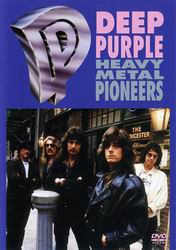Deep Purple-Heavy Metal Pioneers (1991) (NTSC) |
|
Deep Purple-Heavy Metal Pioneers (1991) (NTSC) |
|


|
| BUY IT |
| General | Extras | ||
| Category | Documentary | None | |
| Rating |

|
||
| Year Of Production | 1991 | ||
| Running Time | 57:33 | ||
| RSDL / Flipper | No/No | Cast & Crew | |
| Start Up | Programme | ||
| Region Coding | 2,3,4,5,6 | Directed By | Paul Justman |
|
Studio
Distributor |
 Warner Vision |
Starring |
Jon Lord Roger Glover Ian Paice Ritchie Blackmore Joe Lynn Turner |
| Case | Amaray-Transparent-Secure Clip | ||
| RPI | $34.95 | Music | Deep Purple |
| Video (NTSC) | Audio | ||
| Pan & Scan/Full Frame | Full Frame | English Linear PCM 48/16 2.0 (1536Kb/s) | |
| Widescreen Aspect Ratio | None | ||
| 16x9 Enhancement | No | ||
| Video Format | 480i (NTSC) | ||
| Original Aspect Ratio | 1.33:1 | Miscellaneous | |
| Jacket Pictures | No | ||
| Subtitles |
English Japanese |
Smoking | Yes |
| Annoying Product Placement | No | ||
| Action In or After Credits | No | ||
Putting the title aside, the documentary is very interesting, featuring interviews from all of the Mark II line-up band members, apart from Ian Gillan. This is a big pity, but not that unexpected when you remember that the doco was recorded in 1991. At that time the prevailing line-up was Mark V, featuring the rather forgettable Joe Lynn Turner as replacement lead vocalist. The good news though is that the focus of this doco is very firmly on the early Purple years. It gives a great insight into the lesser-known facts surrounding the formation of the band and the whirlwind experiences of the Mark I lineup, before moving on to spend the lion's share of the documentary time discussing in depth the Mark II and then Mark III eras (covering the most well-known material between the 1970 In Rock album and 1974's Stormbringer album). The documentary then skims through the intervening years until 1984, when Mark II is reincarnated for the great Perfect Strangers release, before the documentary rounds off neatly to bring the story right up to date through to Mark V's Slaves and Masters album.
Re-reading the above paragraph, I've just realised you may well be getting head spins by now if you are not familiar with the Deep Purple discography and line-up history - welcome to the tangled mess that is Deep Purple's history, where line-up changes and roman numerals abound to distinguish them! To put the history into perspective for you, a very useful reference is contained in the fan site TheHighwayStar.com, under their discography page.
OK, so who is interviewed in this documentary and when were the interviews recorded? The documentary features excerpts from both newly recorded interviews (at the time), complemented by some older interview and backstage snippets. The newly recorded interviewees are Jon Lord, Roger Glover, Ian Paice, Ritchie Blackmore and Joe Lynn Turner. Apart from the band members, one other key interviewee is manager Bruce Payne, although he appears only very briefly.
Aside from the fact that this documentary is told through the band members' own words, and is therefore authoritative, what makes this documentary so interesting is that it contains some great rare archival footage of the band's past live performances, dating all the way back to 1968. The footage may be of poor quality (refer below), but it is all fascinating to see. For the record, the documentary includes live performance footage of the following songs (note: this not a song list though, they are extracts only): Hush, Black Night, Speed King, Child In Time, Highway Star, Smoke On The Water, Strange Kind of Woman, Woman From Tokyo, Burn, Stormbringer and Perfect Strangers. The documentary also contains an excerpt from the King of Dreams music video.
All footage, including all the newer 1991 interviews, has been shot on analogue video and the resulting DVD transfer shows all the limitations of this source medium. Generally speaking, the story of this transfer is the older the footage, the worse the source quality. To add to matters, this is an NTSC transfer, so horizontal resolution is not as strong as it could have been. (Please note that if your TV is not NTSC compatible, then you won't be able to watch this DVD.)
Sharpness is acceptable for the recent interview material, such as the Jon Lord interview, which is referenced most often in the documentary, but the limitations of analogue video are apparent throughout in poor background resolution, plenty of low level noise, and a generally grainy image. Still, the 1991 stuff is adequate enough for the purpose. The resolution of the archival concert footage is extremely variable. Some concerts, such as the 1974 California Jam, were recorded professionally for ABC-TV and is, well, of passable quality I suppose. Other concerts are from much earlier and smaller venue gigs recorded by amateur cameramen, and so of lesser quality at the source. At the bottom of the scale there is some extremely poor quality black and white footage, full of noise and artefacts and no doubt several generations old (see Black Night, chapter 4 and Highway Star, chapter 8).
Colour is pretty good for the most of the 1991 interviews, with the Jon Lord interview being the best and evidencing some nice saturation. Colour in the Roger Glover interview is less impressive, being a bit washed out, and the Ritchie Blackmore interview shoot is worse, being oversaturated and suffering from colour bleeding. The blacks and darker tones are satisfactory in the Jon Lord interview sequences, but by and large are not solid, suffering from the noise introduced by analogue video source. Colour in the remainder of the archival footage is up and down.
Source artefacts are abundant in this transfer. There is quite a catalogue of them. The most annoying is the persistent appearance of microphony effects, manifesting as prominent horizontal lines across many of the video cameras shooting the live concerts. See for examples the footage of the performances of Black Night (chapter 4), Strange Kind of Woman (chapter 6), Smoke On The Water (chapter 7), Speed King (chapter 8) and Perfect Strangers (chapter 11). There is not much that can be done about these annoying lines, it is purely and simply a source issue due to older video camera technology. Other source artefacts in this transfer are chroma noise in numerous background walls, overmodulation (see Ritchie Blackmore interview), colour bleeding (see Ritchie Blackmore excerpts plus the Hush TV shoot in chapter 2) and a very brief analogue tape dropout (during a Roger Glover sequence at 25:46).
The disc contains English and Japanese subtitle streams. I sampled the English track for about half the feature and found it to be quite accurate, missing out only odd words.
This is a single-layer disc.
| Sharpness | |
| Shadow Detail | |
| Colour | |
| Grain/Pixelization | |
| Film-To-Video Artefacts | |
| Film Artefacts | |
| Overall |
There is only one audio track available, an English Linear PCM 48/16 2.0 channel mix (at the high rate of 1536Kb/s). The mix is sufficient for the job, but the source material is devoid of any real punch and makes minimal use of stereo.
Dialogue quality is perfectly fine, with the recordings of all interviewees being quite clear. Many interview sequences do however also contain a notable amount of audio hiss and the Ritchie Blackmore and Roger Glover sequences are the worst for this. Audio sync is spot on for all interviews, but is out for one or two of the archival sequences (see Speed King clip in chapter 3 for example).
The music is carried over well enough in the DVD transfer, but is limited by the quality of the source recordings. My main complain is a distinct lack of bottom end for the music. Bear in mind that nearly all the music on this DVD is source music, taken from the live concerts, and the quality of many of these recordings leaves much to be desired. Some rare recordings are no doubt bootlegs, but even the mix of the ABC TV-recorded 1974 California Jam gig didn't do much for me. The older, smaller venue gig recordings are worse. Many of the source recordings are in mono too, with the footage having been shot for 1960s and 1970s TV broadcast. But still, having given all of these caveats, I note that all of this source material is rare footage - in some cases very rare bootlegs - so we cannot expect high quality too. The quality is quite passable in the context of offering rare footage for a TV documentary.
| Dialogue | |
| Audio Sync | |
| Clicks/Pops/Dropouts | |
| Surround Channel Use | |
| Subwoofer | |
| Overall |
The menu screen, should you select it manually with your remote control, is a very basic, static, 1.33:1 single screen to facilitate chapter selection and subtitle selection only. (Note this menu screen is also deficient with respect to subtitle options; it doesn't indicate the fact, but the disc contains a Japanese subtitle stream.)
NOTE: To view non-R4 releases, your equipment needs to be multi-zone compatible and usually also NTSC compatible.
The quality of the source materials for this feature is its biggest limitation. However the DVD transfer itself is fine and quality of the overall product is perfectly satisfactory in context. Variable video and audio and no extras, but a thoroughly enjoyable music documentary.
| Video | |
| Audio | |
| Extras | |
| Plot | |
| Overall |
| Review Equipment | |
| DVD | Toshiba 2109, using Component output |
| Display | Toshiba 117cm widescreen RPTV. Calibrated with AVIA Guide To Home Theatre. This display device is 16x9 capable. |
| Audio Decoder | Yamaha RXV-1000. Calibrated with AVIA Guide To Home Theatre. |
| Amplification | Elektra Home Theatre surround power amp |
| Speakers | Orpheus Aurora III mains, Orpheus Centaurus 1.0 centre, Velodyne CT150 sub and B&W DM303 rears |